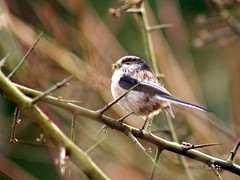A delightful and often confiding little bird, the Long tailed tit (Aegithalos caudatus) has a proportionally long tail and almost spherical body. The long-tailed tit is often seen in large animated flocks; it moves in a rather jerky fashion and has acrobatic feeding habits. In flight, which is rather undulating, the bird resemble flying feather dusters. The sexes are similar.The adult can look rather black and white at distance. At close range, there is a pinkish-chestnut patch on the scapulars and whitish wing feather fringes on the otherwise black back and wings. The head is mainly whitish, with a broad, black band running above the eye; the underparts are whitish but suffused with pink on the flanks and belly.
The long-tailed tit is associated mainly with deciduous woodland, areas of scrub, particularly on heathland fringes, and mature hedgerows. Several hundred thousand pairs on present in the UK as a whole, with it being most common in southern England. In the breeding season, the long-tailed tit will construct a beautiful ball-shaped nest, made from feathers and spiders silk, and camouflaged with a coating of lichens; these are often built-in the cover of dense, spiny bushes such as gorse, as protection from predators.
The bird utters a rattling tsrrr contact call and a thin tsee-tsee-tsee.
Reference List:
- Sterry.P., (2004) Collins Complete Guide to British Birds. Harper Collins Publishing Ltd, London.


